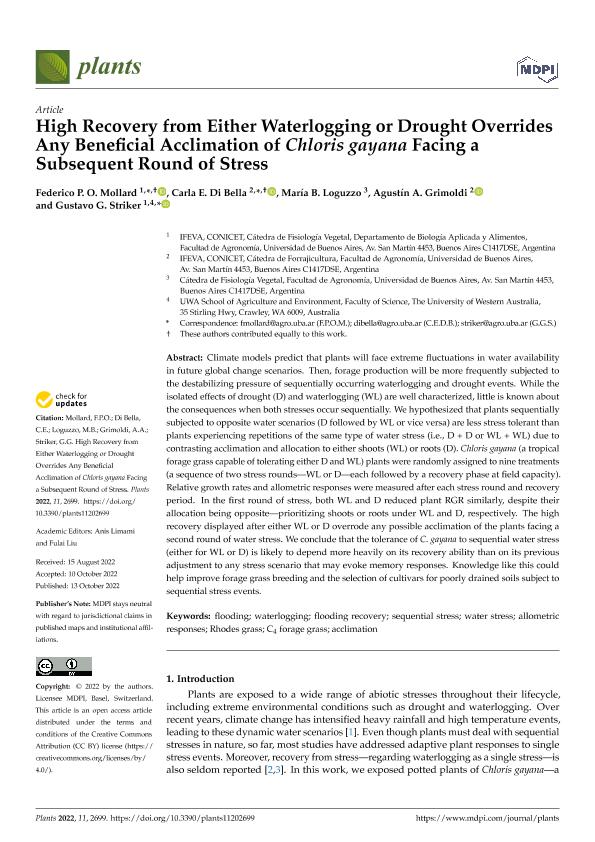Mostrar el registro sencillo del ítem
dc.contributor.author
Mollard, Federico Pedro Otto

dc.contributor.author
Di Bella, Carla Estefania

dc.contributor.author
Loguzzo, Maria Belen

dc.contributor.author
Grimoldi, Agustin Alberto

dc.contributor.author
Striker, Gustavo Gabriel

dc.date.available
2023-08-17T18:05:04Z
dc.date.issued
2022-10
dc.identifier.citation
Mollard, Federico Pedro Otto; Di Bella, Carla Estefania; Loguzzo, Maria Belen; Grimoldi, Agustin Alberto; Striker, Gustavo Gabriel; High Recovery from Either Waterlogging or Drought Overrides Any Beneficial Acclimation of Chloris gayana Facing a Subsequent Round of Stress; Multidisciplinary Digital Publishing Institute; Plants; 11; 20; 10-2022; 1-12
dc.identifier.issn
2223-7747
dc.identifier.uri
http://hdl.handle.net/11336/208643
dc.description.abstract
Climate models predict that plants will face extreme fluctuations in water availability in future global change scenarios. Then, forage production will be more frequently subjected to the destabilizing pressure of sequentially occurring waterlogging and drought events. While the isolated effects of drought (D) and waterlogging (WL) are well characterized, little is known about the consequences when both stresses occur sequentially. We hypothesized that plants sequentially subjected to opposite water scenarios (D followed by WL or vice versa) are less stress tolerant than plants experiencing repetitions of the same type of water stress (i.e., D + D or WL + WL) due to contrasting acclimation and allocation to either shoots (WL) or roots (D). Chloris gayana (a tropical forage grass capable of tolerating either D and WL) plants were randomly assigned to nine treatments (a sequence of two stress rounds—WL or D—each followed by a recovery phase at field capacity). Relative growth rates and allometric responses were measured after each stress round and recovery period. In the first round of stress, both WL and D reduced plant RGR similarly, despite their allocation being opposite—prioritizing shoots or roots under WL and D, respectively. The high recovery displayed after either WL or D overrode any possible acclimation of the plants facing a second round of water stress. We conclude that the tolerance of C. gayana to sequential water stress (either for WL or D) is likely to depend more heavily on its recovery ability than on its previous adjustment to any stress scenario that may evoke memory responses. Knowledge like this could help improve forage grass breeding and the selection of cultivars for poorly drained soils subject to sequential stress events.
dc.format
application/pdf
dc.language.iso
eng
dc.publisher
Multidisciplinary Digital Publishing Institute
dc.rights
info:eu-repo/semantics/openAccess
dc.rights.uri
https://creativecommons.org/licenses/by/2.5/ar/
dc.subject
ACCLIMATION
dc.subject
ALLOMETRIC RESPONSES
dc.subject
C4 FORAGE GRASS
dc.subject
FLOODING
dc.subject
FLOODING RECOVERY
dc.subject
RHODES GRASS
dc.subject
SEQUENTIAL STRESS
dc.subject
WATER STRESS
dc.subject
WATERLOGGING
dc.subject.classification
Otras Ciencias Agrícolas

dc.subject.classification
Otras Ciencias Agrícolas

dc.subject.classification
CIENCIAS AGRÍCOLAS

dc.title
High Recovery from Either Waterlogging or Drought Overrides Any Beneficial Acclimation of Chloris gayana Facing a Subsequent Round of Stress
dc.type
info:eu-repo/semantics/article
dc.type
info:ar-repo/semantics/artículo
dc.type
info:eu-repo/semantics/publishedVersion
dc.date.updated
2023-07-28T10:27:27Z
dc.journal.volume
11
dc.journal.number
20
dc.journal.pagination
1-12
dc.journal.pais
Suiza

dc.journal.ciudad
Basilea
dc.description.fil
Fil: Mollard, Federico Pedro Otto. Consejo Nacional de Investigaciones Científicas y Técnicas. Oficina de Coordinación Administrativa Parque Centenario. Instituto de Investigaciones Fisiológicas y Ecológicas Vinculadas a la Agricultura. Universidad de Buenos Aires. Facultad de Agronomía. Instituto de Investigaciones Fisiológicas y Ecológicas Vinculadas a la Agricultura; Argentina
dc.description.fil
Fil: Di Bella, Carla Estefania. Consejo Nacional de Investigaciones Científicas y Técnicas. Oficina de Coordinación Administrativa Parque Centenario. Instituto de Investigaciones Fisiológicas y Ecológicas Vinculadas a la Agricultura. Universidad de Buenos Aires. Facultad de Agronomía. Instituto de Investigaciones Fisiológicas y Ecológicas Vinculadas a la Agricultura; Argentina
dc.description.fil
Fil: Loguzzo, Maria Belen. Universidad de Buenos Aires. Facultad de Agronomía. Departamento de Biología Aplicada y Alimentos. Cátedra de Fisiología Vegetal; Argentina
dc.description.fil
Fil: Grimoldi, Agustin Alberto. Consejo Nacional de Investigaciones Científicas y Técnicas. Oficina de Coordinación Administrativa Parque Centenario. Instituto de Investigaciones Fisiológicas y Ecológicas Vinculadas a la Agricultura. Universidad de Buenos Aires. Facultad de Agronomía. Instituto de Investigaciones Fisiológicas y Ecológicas Vinculadas a la Agricultura; Argentina
dc.description.fil
Fil: Striker, Gustavo Gabriel. Consejo Nacional de Investigaciones Científicas y Técnicas. Oficina de Coordinación Administrativa Parque Centenario. Instituto de Investigaciones Fisiológicas y Ecológicas Vinculadas a la Agricultura. Universidad de Buenos Aires. Facultad de Agronomía. Instituto de Investigaciones Fisiológicas y Ecológicas Vinculadas a la Agricultura; Argentina. University of Western Australia; Australia
dc.journal.title
Plants
dc.relation.alternativeid
info:eu-repo/semantics/altIdentifier/url/https://www.mdpi.com/2223-7747/11/20/2699
dc.relation.alternativeid
info:eu-repo/semantics/altIdentifier/doi/http://dx.doi.org/10.3390/plants11202699
Archivos asociados
